QA vs. Software testing - What's the difference?
There's a common misconception that Quality Assurance (QA) and software testing are interchangeable terms. While some recognize a fundamental distinction between the two, articulating it can be challenging.
Whether you effortlessly navigate this debate or find it a bit murky, our goal with this post is to bring clarity. We'll explore the nuances between QA and software testing, emphasizing why both play important roles in guaranteeing the delivery of high-caliber products.
We can help you drive global growth, better accessibility and better product quality at every level.
QA vs. Software testing – Definition
Software testing is the systematic process of examining a software application to uncover defects or discrepancies, ensure it operates as intended, and meet user requirements. It involves:
- Designing and executing test cases
- Identifying and documenting any issues found, and
- Iteratively refining the software to enhance its functionality, reliability, and performance.
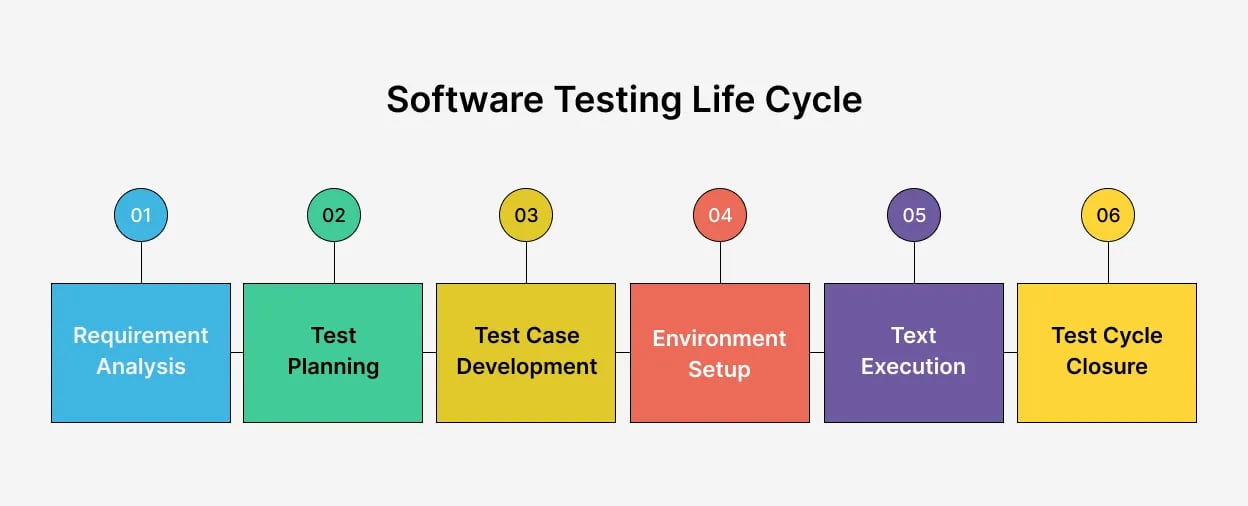
For example, software testing is like thoroughly checking a new car to ensure it runs smoothly. Testers carefully examine every part, looking for glitches or issues, and report back to improve the car's performance and reliability.
In contrast, quality assurance (QA) is the process of implementing standards and procedures to ensure high-quality software development. It involves setting goals, monitoring processes, and continuously improving to meet customer expectations and prevent defects.
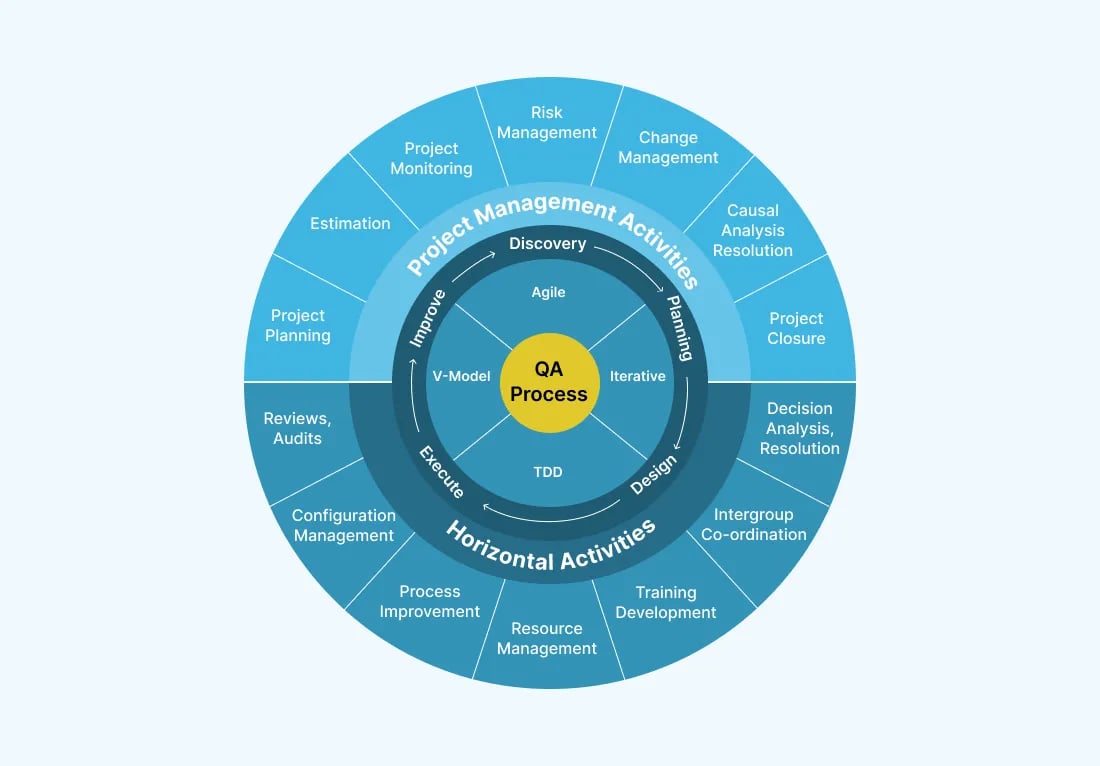
Following the car metaphor, quality assurance is about setting high car construction and maintenance standards. It involves implementing efficient processes, constantly seeking ways to improve, and ensuring everyone follow the rules to produce top-notch cars consistently.
QA vs. Software testing – Characteristics
Software testing characteristics:
- Purpose: Identify defects to ensure product quality.
- Scope: Focus on software functionality and defect discovery.
- Involvement: Testers execute tests, report issues, and verify fixes.
- Techniques: Use automation tools and manual tests.
- Responsibilities: Ensure software meets quality standards.
- Deliverables: Reports containing defect lists and test summaries.
- Purpose: Ensure software meets requirements and is defect-free.
- Scope: Implement processes, procedures, and standards for quality.
- Involvement: Monitor development, review documentation, and audit the product.
- Techniques: Utilize automation tools and manual inspections.
- Responsibilities: Ensure compliance with industry standards.
- Deliverables: Reports with non-conformance lists and audit summaries.
QA vs. Software testing – Different types
Software testing types:
Functional testing focuses on verifying specific software functions, while non-functional testing evaluates aspects like performance, security, usability, and compatibility: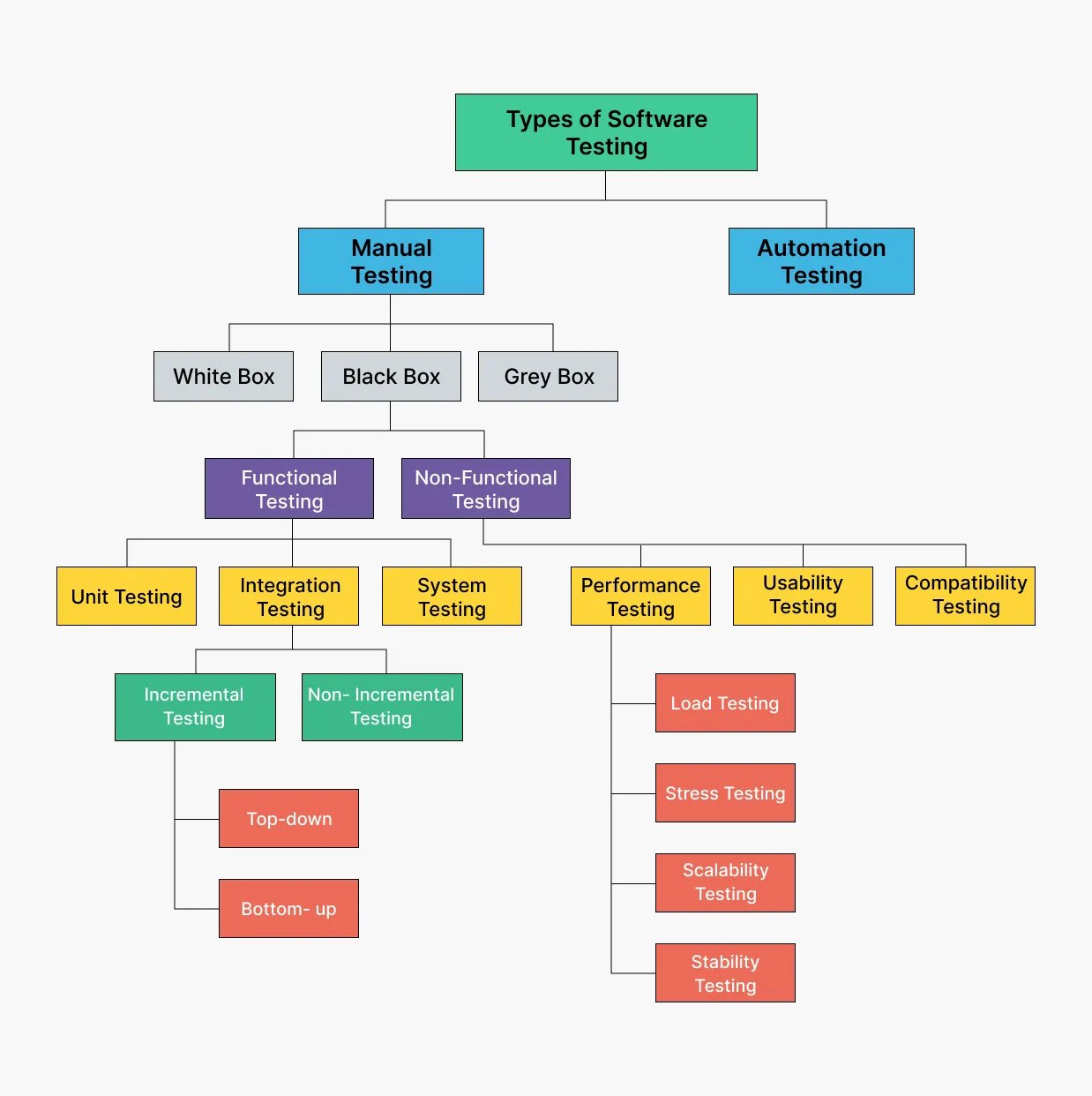
Some of the most common functional testing types are:
- Acceptance Testing verifies whether the entire system functions as intended, ensuring its acceptability. It also evaluates the system's compliance with business requirements. Acceptance testing can include user acceptance testing, business acceptance testing, alpha testing, and beta testing.
- Integration Testing: This phase tests individual software modules as a group to assess compliance with specified functional requirements. Integration testing identifies faults in the interaction between integration units and occurs between unit and system testing.
- Unit Testing: Developers conduct unit testing to validate each unit of software code's performance against expectations. This process is performed during the application development phase and can save resources if executed properly early in development.
Non-functional testing types are, among others:
- Performance Testing: Evaluates system performance regarding responsiveness and stability under workload conditions. It examines speed, reliability, robustness, and application size, utilizing indicators such as response times, server processing time, CPU memory consumption, and error types.
- Regression Testing: This method ensures that changes or additions to software applications do not disrupt existing functionality. It involves re-executing partial or full sets of test cases to verify that existing functionalities remain unaffected.
- Sanity Testing: This quick evaluation checks whether the material produced is rational. It helps rule out obviously false results and ensures that methodologies are functioning as expected by briefly running through various functionalities.
Quality Assurance testing types:
Quality assurance testing is essential to identify and prevent errors, improve future products, and promote overall growth.
Here are different types of QA testing:
- Regression Testing: QA testers ensure the software's functionality remains unchanged after new code additions, ensuring no disruption to existing integration.
- Mobile Testing: This focuses on testing performance and usability under various conditions such as incoming phone calls, low battery, or multitasking. Mobile testing is distinct due to the diverse characteristics, memory storage, and screen sizes of mobile devices, presenting unique challenges.
- User Acceptance Testing (UAT): UAT is a form of quality assurance testing where end-users test the software to uncover unforeseen performance and user experience issues, providing valuable feedback to developers.
- Data Conversion Testing: This testing checks the application's data conversion functionality, identifies defects, and ensures compatibility between old and new systems.
QA vs. Software testing – Advantages
Benefits of Software testing:
- Bug detection: Testing identifies and resolves defects and bugs in the software, ensuring it operates correctly and meets user expectations.
- Enhanced reliability: Thorough testing improves the reliability and stability of the software, reducing unexpected failures and crashes.
- Increased security: Security testing uncovers vulnerabilities, enabling timely fixes to protect against threats and data breaches.
- Performance optimization: Testing identifies performance issues, allowing for optimization and faster response times.
- Cost savings: Early defect detection in development is more cost-effective than addressing issues in production.
- Compliance: Testing ensures software complies with industry regulations and legal requirements.
- Quality enhancement: Testing improves software quality by identifying and fixing defects before release, enhancing the user experience and satisfaction.
- Early detection: Detecting defects early reduces development costs and time to market.
- Enhanced User Experience: Testing optimizes the user experience, increasing product appeal and customer satisfaction and potentially boosting sales.
Benefits of Quality Assurance testing:
- Process improvement: Quality assurance focuses on optimizing development processes, which leads to more efficient and effective workflows, reduced waste, and improved productivity. This continuous improvement approach ensures consistent delivery of high-quality products.
- Consistency: QA practices promote consistency in software development, ensuring that all team members adhere to best practices and standards.
- Prevention of defects: By implementing quality assurance measures, organizations can proactively prevent defects and errors, reducing the need for extensive testing and rework.
- Risk mitigation: QA identifies risks and issues early, allowing proactive risk mitigation strategies to be implemented. This minimizes potential disruptions and ensures smooth project execution.
- Competitive advantage: Organizations prioritizing quality assurance gain a competitive advantage by delivering more reliable and superior software products, which sets them apart in the market and attracts more customers.
- Resource efficiency: QA helps to efficiently allocate resources by targeting areas with the potential for significant quality improvements, leading to optimal resource utilization and maximum ROI.
- Data-driven decision-making: Continuous optimization through data-driven decision-making is the cornerstone of QA, ensuring effective problem-solving.
- Enhanced usability: Ensuring the software's user interface is intuitive and easy to use through quality assurance enhances usability, improves user satisfaction, and promotes efficient software utilization.
- Increased productivity: Efficient development through quality assurance streamlines workflows and ensures timely delivery of quality products.
- Improved customer satisfaction: Quality assurance ensures that the product meets customer requirements and functions as expected, increasing customer satisfaction.
QA vs. Software testing – Limitations
Software testing limitations:
- Resource constraints: Software testing requires significant resources such as skilled personnel, testing tools, and testing environments. Limited resources may restrict the thoroughness and effectiveness of testing.
- Compatibility: Testing software across different platforms, devices, and configurations can be challenging. Testing for compatibility with various operating systems, browsers, hardware, and software versions may be limited.
- Dynamic nature: Software systems are dynamic and constantly evolving. Testing may become outdated as new features are added or existing ones are modified. Continuous testing and regression testing are necessary to ensure ongoing quality.
- Human error: Despite rigorous testing procedures, human error can still occur. Testers may overlook certain scenarios, misinterpret requirements, or make mistakes during test execution, which can lead to potential issues in the software.
- Dependencies: Software often relies on external components, libraries, or services. Testing the software in isolation may not uncover issues related to these dependencies. Integration testing is essential to validate the interactions between different system parts.
- User perspective: Testing may not always capture the user's perspective or real-world usage scenarios. User acceptance testing (UAT) involving actual users can provide valuable feedback but may not cover all possible scenarios.
- Security: Testing for security vulnerabilities is crucial, but it can be challenging to identify all potential threats and vulnerabilities. Security testing requires specialized knowledge and tools and may still result in undiscovered vulnerabilities.
- Regulatory compliance: Software may need to comply with various regulatory standards and industry-specific requirements. Testing for compliance can be complex and may require additional expertise and resources.
- Communication: Miscommunication or unclear requirements can lead to misunderstandings and inadequate testing coverage.
Quality assurance limitations:
- Scalability: QA processes may not scale effectively as the size and complexity of the software project increase. Testing strategies that work well for small projects may not be sufficient for larger, more complex systems.
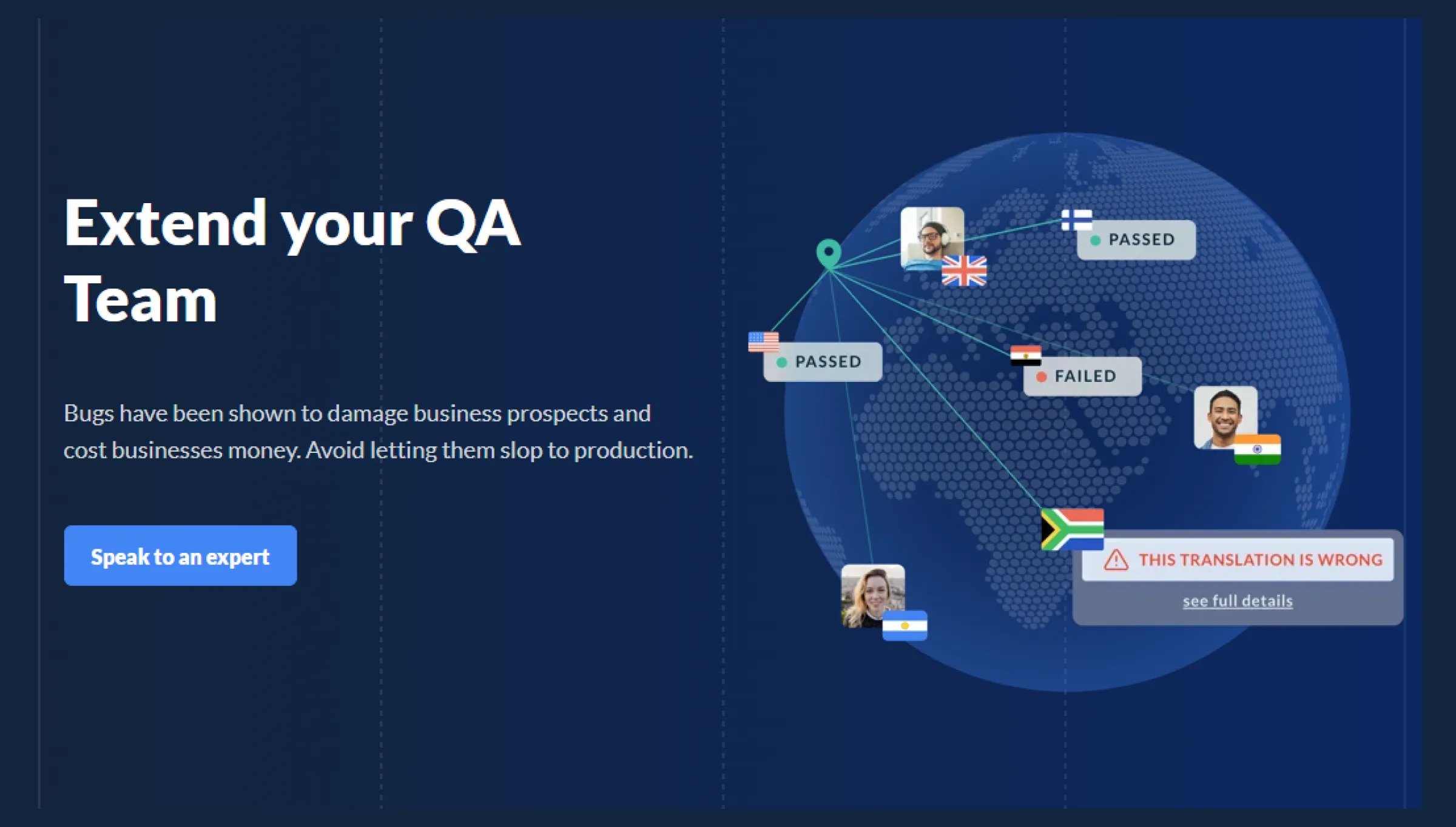
- Subjectivity: It often involves subjective judgments about the software's quality and usability. Different testers may have varying interpretations of quality criteria, leading to inconsistencies in the evaluation process.
- Tool limitations: While QA tools can automate many aspects of testing, they may have limitations in functionality, compatibility, or ease of use. Relying too heavily on automated tools without human oversight can result in overlooked issues or false positives.
- Time constraints: QA activities must often be completed within tight deadlines to keep up with development schedules. Limited time may compromise testing's thoroughness or force testers to prioritize certain areas over others, potentially overlooking critical issues.
- Legacy systems: Testing strategies may need to be adapted to accommodate legacy systems, increasing the difficulty and cost of quality assurance efforts.
- Communication gap: Misunderstandings or lack of communication can lead to incomplete or ineffective testing, resulting in quality issues slipping through the cracks.
- Regulatory compliance: Quality assurance must ensure software meets regulatory requirements and industry standards. Compliance testing adds an additional layer of complexity and can require specialized knowledge and resources.
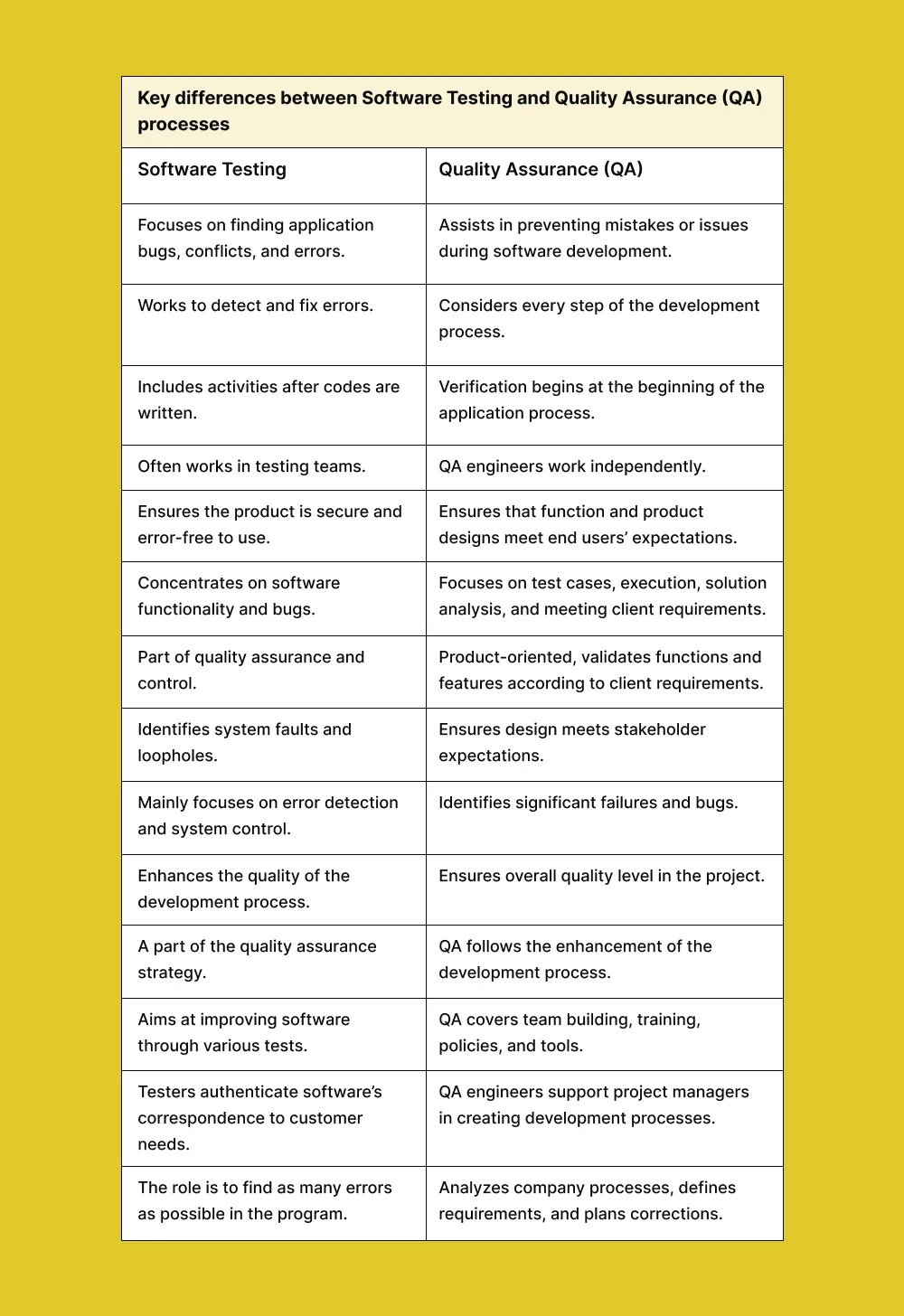
How to choose between Software Testing and QA testing
The choice between quality assurance and testing should be driven by the specific needs of each project or company, given that these processes are interdependent. Here are a few points to consider:
1. Scope of tasks:
- Quality assurance involves a broader range of activities, including quality planning, process improvement, and audits.
- Software testing primarily focuses on identifying defects and issues through testing procedures.
- Consider your project's specific needs. Software testing may be necessary if a comprehensive analysis of program functionality, efficiency, and reliability is crucial.
- Evaluate the scope and complexity of your project. Prioritizing software testing may be more practical for smaller assignments with limited resources and tight deadlines.
- Assess the long-term goals of your company. Investing in quality assurance can foster a culture of quality across projects and ensure consistent delivery of high-quality software.
- Alternatively, prioritizing software testing may be more suitable for companies focused on rapid software release cycles and immediate issue resolution.
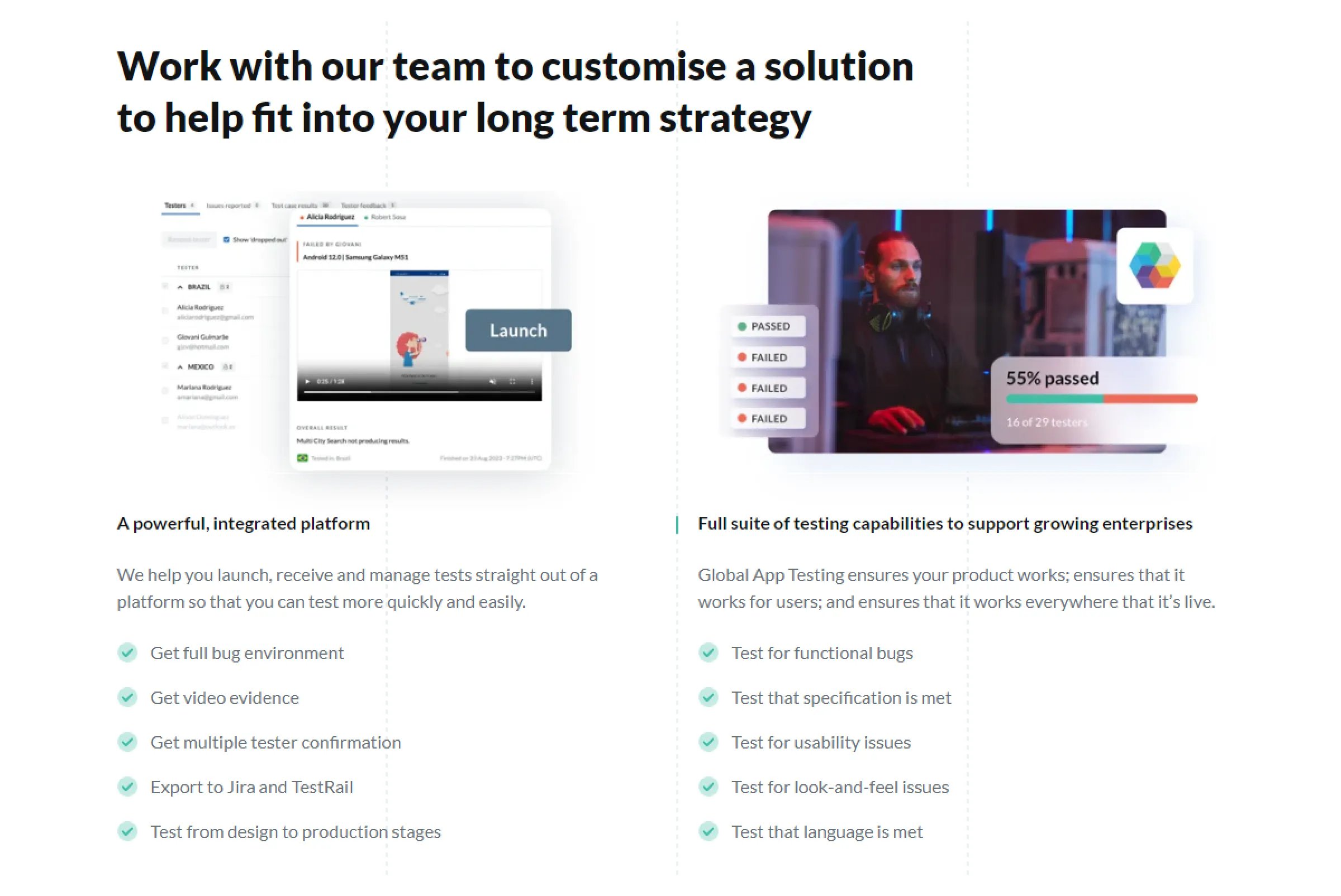
Global App Testing offers:
- Full suite of testing capabilities to support growing enterprises in every step of the development cycle.
- Powerful platform for launching, receiving, creating, managing, and tracking both automated and manual testing processes. With add-on features such as real-time dashboard access and integrated workflow, it facilitates efficient testing management to meet your project's needs.
- Guides, webinars, and reports to help you drive best practices.

Interested to learn more?
Schedule a call with our QA specialist today, and let's build a high-quality product together!
We can help you drive localization as a key initiative aligned to your business goals
FAQ
How are Software testing and QA testing related?
Software testing is a subset of Quality Assurance (QA) Testing. While Software testing explicitly deals with verifying the software's functionality and performance, QA testing covers a broader scope, including:
- Process improvement
- Quality management, and
- Adherence to standards.
What are the objectives of software testing?
The primary objective of Software testing is to identify defects or bugs in the software application to ensure its reliability, functionality, and performance. It aims to verify that the software meets specified requirements and works correctly under various conditions.
What are the objectives of QA testing?
The objectives of QA testing include:
- Ensuring that the software development process follows defined standards and best practices.
- Identifying areas for process improvement.
- Minimizing defects.
- Enhancing the overall quality of the software product.
Who performs software testing?
Software testing is typically performed by dedicated testers or quality assurance engineers who specialize in designing and executing test cases, identifying defects, and ensuring the quality of the software product.
Who performs QA testing?
QA testing is performed by QA engineers or professionals who are responsible for establishing quality processes, defining testing methodologies, conducting audits, and ensuring that the entire software development lifecycle meets quality standards.
Keep learning
6 iOS testing frameworks to use
Android mobile app testing checklist for testing
The only functional testing checklist you need

